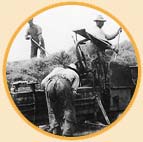Baling Hay
 Some farmers baled their surplus hay to sell it. The usual method of baling hay used a
horse powered stationary hay press. This machine was often operated by custom
outfits travelling from farm to farm. Hay presses compressed hay to between
one-quarter and one-eighth of its original bulk. Some farmers baled their surplus hay to sell it. The usual method of baling hay used a
horse powered stationary hay press. This machine was often operated by custom
outfits travelling from farm to farm. Hay presses compressed hay to between
one-quarter and one-eighth of its original bulk.
A hay press
consisted of a square compression chamber and a plunger. Horses provided the
power by walking in a circle, operating the plunger. The hay had to be forked
into the chamber by hand. When enough hay had been forked into the press and
compressed to form a bale, a crewman tied it by hand. He did this with either
wire or twine before the bale was ejected. The size of the bales varied with the
size of the press, but a common size was 35 x 45 x 90 centimetres. A one-horse outfit
could bale 453 kilograms of hay an hour.
The farm family
and neighbours rounded out the baling crew, as it took about six people to
operate a medium-sized hay press. Two people fed the baler, one tied the bales,
another removed the finished bales and extra hands were needed to tend the
horses.
Two Albertans
patented ideas to facilitate baling. Ira Pasley of Olds patented a hay press
accessory in 1905: a bell that signaled when the bales were the proper size to
be tied. In 1912, Earl Goodwin of Pincher Station patented a tucking plate that
made it easier to feed the hay into the press.
The hay press
was the first haymaking machine to run successfully on engine power. For
example, International Harvester introduced an engine-powered press in 1909.
Belt-powered hay presses were a later option, driven by tractors in the same
manner as a threshing machine. Few individual farmers owned presses because they
were so expensive. In 1921, a two-horse International Harvester press cost as
much as four or five mowers, and an engine-powered unit cost much more. As a
result, individual ownership was largely limited to bigger farms that
specialized in hay sales, such as those that produced alfalfa under irrigation,
and hay contractors. Hay presses were used extensively until about 1944 when
International Harvester introduced its 50T automatic tie pick-up baler pulled
by a tractor. This machine quickly made hay presses obsolete, and by 1950, no
new hay presses were sold in Alberta. At the same time, the demand for
horse-drawn mowers and rakes dropped as the horse-powered era of hay-making in
Alberta rapidly drew to a close.
Judy Larmour. Making Hay While the Sun Shone: Haying in Alberta Before 1955. n.p.: Friends of
Reynolds-Alberta Museum Society and Alberta Culture and Multiculturalism, Historic Sites and Archives Service, 1992. With permission from
Friends
of the Reynolds-Alberta Museum Society.

|
 Heritage Community Foundation Presents
Heritage Community Foundation Presents





